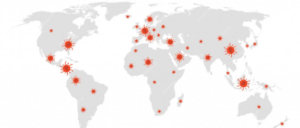Respiratory viruses
- Influenza
Influenza is a contagious respiratory infection caused by influenza viruses, which are unique due to their vast genetic variability. It is a public health issue because of the seasonal outbreaks that affect 2 to 6 million people in France every winter, with influenza-associated excess mortality estimated at approximately 10,000 deaths, mainly in vulnerable individuals. The pandemic risk associated with zoonotic influenza is also a major public health challenge. In addition to hygiene measures, the annual influenza vaccine is the most effective means of protection.
- SARS-CoV-2 coronavirus
The SARS-CoV-2 coronavirus, discovered in December 2019 in the province of Wuhan in China, is responsible for COVID-19. This highly contagious emerging infectious disease spreads by airborne transmission and surface contamination. Although COVID-19 can be asymptomatic, it can also cause a variety of symptoms, including severe respiratory distress that may prove fatal. Vaccination and basic health and hygiene practices are essential to reduce the spread of the virus.
- Respiratory syncytial virus
Respiratory syncytial virus (RSV) causes infections of the lungs and respiratory tract. Respiratory syncytial (sin-SISH-ul) virus can also infect adults.
In adults and older, healthy children, respiratory syncytial virus (RSV) symptoms are mild and typically mimic the common cold. Self-care measures are usually all that’s needed to relieve any discomfort.
RSV can cause severe infection in some people, including babies 12 months and younger (infants), especially premature infants, older adults, people with heart and lung disease, or anyone with a weak immune system (immunocompromised).
Respiratory syncytial virus (RSV) is the most common cause of viral acute lower respiratory tract infections in children younger than 5 years of age worldwide and is also associated with infant mortality in low-income countries. The ubiquitous nature of this infection is evident from population studies, showing that about 90% of children contract RSV by the age of 3 years. In high-income countries, RSV ranks among the top causes of outpatient visits for children and leads to hospitalization in 1%–3% of all infants during their first year of life. This substantial number of hospital admissions during RSV epidemics places immense strain on hospital resources, especially when coupled with other concurrent respiratory epidemics such as influenza and severe acute respiratory syndrome coronavirus-2 (SARS-CoV-2).
The significant global burden of RSV-related morbidity underscores the need for preventive strategies, encompassing both nonpharmaceutical interventions (NPI), which have shown efficacy during the SARS-CoV-2 pandemic, and pharmaceutical interventions. Recent pharmaceutical advancements offer promising avenues for reducing the impact of RSV in infants, including passive immunization utilizing a long-lasting monoclonal antibody (nirsevimab) as well as vaccination during pregnancy.

